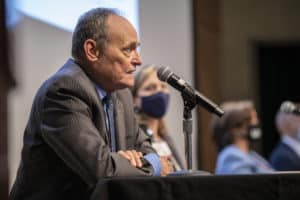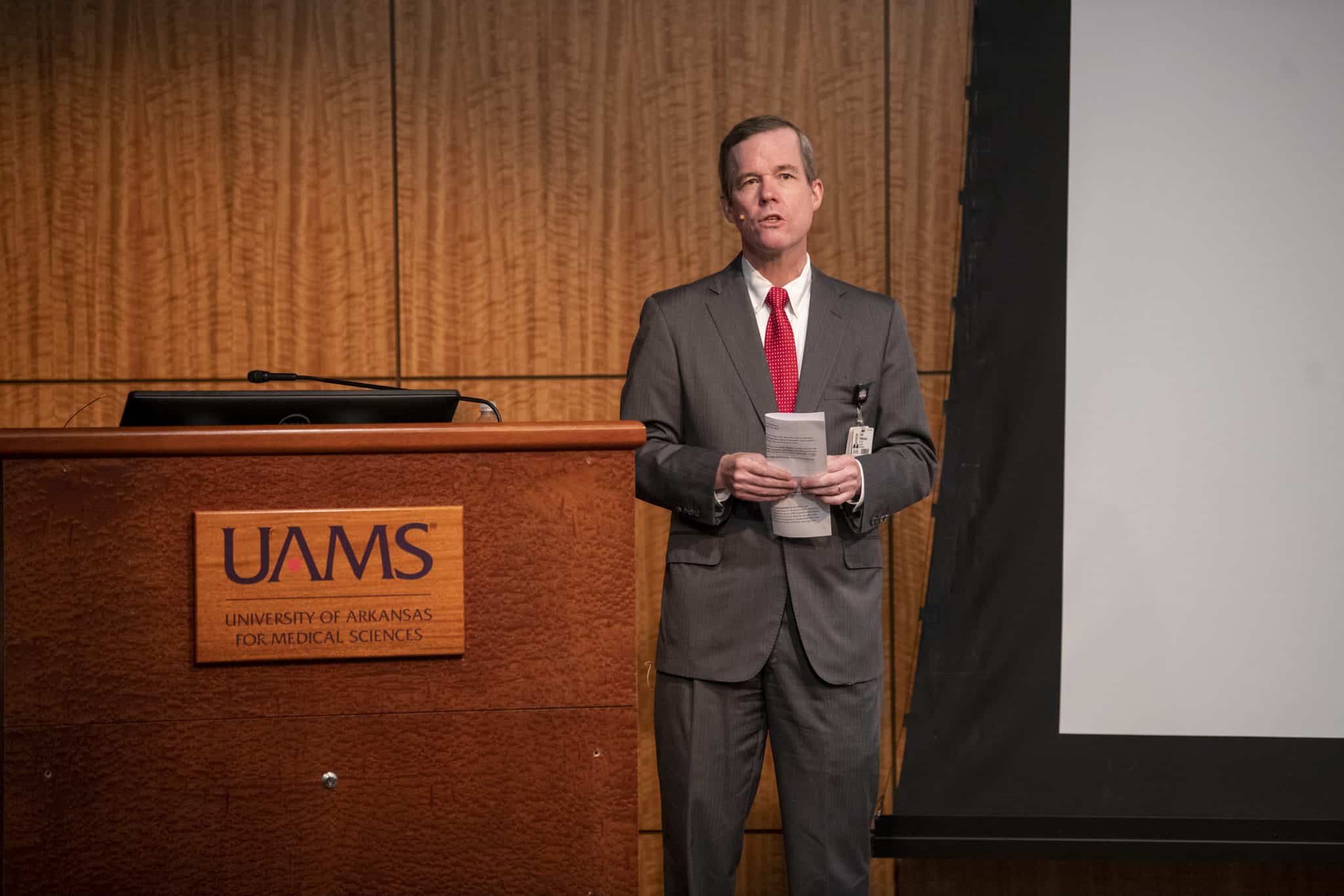Chancellor Praises Team UAMS at August Town Hall Meeting
| Chancellor Cam Patterson, M.D., MBA, praised Team UAMS for recent accolades awarded the university and Medical Center as he kicked off his Aug. 12 Town Hall in the Spine Institute’s Fred W. Smith Auditorium.

Patterson (left) invited four members of his Cabinet to present at the Aug. 12 Town Hall. They are (from left) Michael Birrer, M.D., Ph.D.; Amanda George, M.H.S.A., CPA; Danielle Lombard-Sims, Ph.D.; and Mark Williams, Ph.D.
For the second year, U.S. News & World Report recognized UAMS as having the best hospital in Arkansas and ranked the ear, nose and throat (ENT) department among the top 50 nationwide. Several UAMS services and procedures were singled out as “high performing,” including COPD, colon cancer surgery, heart failure, hip replacement, knee replacement and lung cancer surgery.
The publication also named the UAMS College of Pharmacy as one of the best colleges of pharmacy nationwide, with it ranking 31st among 134 colleges.
UAMS also was chosen as the “Best Place to Work” in the Arkansas Times’ 2020 Best of Arkansas poll, Patterson said, a “feat that was only possible because we have the best employees.”
“All of these accolades confirm what we already know – UAMS is providing top-notch health care and education to the people of Arkansas,” Patterson said.
Patterson also played two new commercials UAMS started airing this month. The commercials, produced by Creative Services, are designed to assure patients UAMS is open for business and taking every precaution for their safety.
NCI Designation

Birrer, director of the Winthrop P. Rockefeller Cancer Institute and vice chancellor, gives an update on UAMS’ efforts to secure NCI designation.
Michael Birrer, M.D., Ph.D., director of the Winthrop P. Rockefeller Cancer Institute and vice chancellor, gave an update on UAMS’ efforts to secure NCI designation, a recognition by the National Cancer Institute that only is awarded to cancer centers with significant laboratory and clinical research capabilities as well as exceptional patient care.
“Despite COVID-19, we have continued the important work of recruiting researchers and physicians to come to UAMS,” Birrer said, adding that three offer letters are being finalized. Twelve oncologists have been hired.
The third, sixth and seventh floors of the Cancer Institute are being finished, part of an $18 million effort, he said. Once completed, the sixth floor will house the Infusion Center and a Phase I unit for clinical trials. Currently, Arkansans who want to be part of a Phase I clinical trial have to leave the state.
UAMS puts about 100 patients into clinical trials each year. In order to achieve NCI designation, UAMS needs to increase that number to 300 a year, Birrer said.
Financial Outlook

Chief Financial Officer Amanda George (second from left) reports that UAMS finished the 2020 fiscal year with a loss of $13.7 million.
Amanda George, M.H.S.A., CPA, vice chancellor for finance and chief financial officer, shared data on key clinical volume indicators – total inpatient discharges, clinic visits, Emergency Department (ED) visits and total surgical cases. Each of these areas hit a low point in April but since have continued to increase, she said.
While inpatient discharges, clinic visits and ED visits in July continue to be lower than the pre-COVID-19 average, the number of total surgical cases actually were 1% higher than the pre-COVID-19 average, she said.
UAMS finished the 2020 fiscal year with a loss of $13.7 million, she said.
“For the year, COVID-19 has had a negative impact of about $36 million, a number that includes the $26.4 million in relief funding we received from the CARES Act,” George said, adding that UAMS has applied for additional grants and assistance.
Resource optimization efforts in such areas as purchase services, length of stay, loss prevention and workforce management also helped UAMS’ bottom line this year, saving $12.1 million in fiscal year 2020, she said. The goal for fiscal year 2021 is $20 million, which is approximately 1% of the UAMS operating budget, she added. The focus areas will include supply chain, length of stay, operating room utilization, workforce management, leases, energy and contracts.
George said once final August numbers are in place, leadership will reassess the hiring pause and the freeze on discretionary spending.
HR Updates

Chief Human Resources Officer Danielle Lombard-Sims (center) announced a number of HR updates during her presentation, including a change in the way UAMS handles Family and Medical Leave Act (FMLA) cases.
Danielle Lombard-Sims, Ph.D., vice chancellor for human resources and chief human resources officer, started her presentation with an encouragement to Team UAMS to complete the census and vote in the November elections, adding that employees may be permitted to arrive late or to depart early from their assigned workstations in order to vote. This time is to be provided with pay and without the use of annual leave, sick leave or compensatory time.
She announced UAMS will be changing how it handles Family and Medical Leave Act (FMLA) cases. Beginning Sept. 1, UAMS will use the third-party vendor FMLASource® to manage all FMLA cases, significantly reducing the administrative tasks currently handled within UAMS departments.
“To those of you who are managing that today, thank you for your hard work, and we are going to be taking that off your shoulders going forward,” she said, adding that FMLASource® will be providing training to leaders.
Wearing masks is an important way UAMS is protecting patients, employees and students, she said. To ensure masks are being worn properly, Team UAMS members will be asked to complete a 10-minute mask training segment on My Compass in the coming weeks, she said. This training will outline UAMS’ mask policy, the correct method for wearing a mask, and when and where a mask must be worn on campus.
Lombard-Sims also announced that neck gaiters and bandanas are no longer allowed at UAMS after a Duke study found them to be ineffective in protecting against COVID-19.
Earlier this year, UAMS employees participated in an Employee Engagement Survey, she said.
“We did an exceptional job with engagement, with 86% of employees completing the survey – well above the national average of 75%,” she said.
The results were very positive, she said, noting that the employment engagement benchmark climbed significantly to the 42nd percentile, and engagement among the nursing staff was the highest among all hospitals.
Now is the time to take some action, she said, as she urged department leaders to meet with their employees, discuss the results and identify one to three action items that their team will work on in the coming months.
She also announced it was time for performance management with reviews taking place between Sept. 1 and Oct. 31, although the system is already open so managers can start the review process early if desired.
“It is important for us to make sure we don’t lose focus on providing feedback to our employees and evaluating how we are doing towards our goals, she said. “Are our goals aligned with Vision 2029? This is the time to have those discussions.”
COVID-19 Update

College of Public Health Dean Mark Williams explains the college’s latest COVID-19 projections, which found that if nothing changes, Arkansas can expect a total of 55,000 COVID-19 cases by Aug. 23.
College of Public Health Dean Mark Williams, Ph.D., presented the college’s latest COVID-19 forecasts. Unlike previous forecasts, long-term projections of the pandemic were not included.
The COPH projection states if nothing changes, Arkansas can expect a total of 55,000 COVID-19 cases by Aug. 23. This number hasn’t increased from the previous forecast, which is good news, he said.
By Aug. 15, Arkansas was projected to have 3,686 total hospitalizations, 1,285 patients in intensive care units and 543 deaths, Williams said, noting that prisoners are excluded from these numbers. (By Aug. 16, Arkansas had 568 non-prisoner deaths, according to the Arkansas Department of Health.)
Williams stressed the model is based on the data currently available and cannot take into account changes that might happen.
“Because of this, the effect of the recent policy requiring Arkansans to wear face masks in public has not yet become evident in data,” he said. “If it will have an effect, as there are early indications it may be, it will be apparent in the next few weeks.”
With schools and universities in Arkansas close to opening, COPH examined how COVID-19 will affect children and young adults in the state. Arkansas data shows the virus is spreading most rapidly in Arkansans between the ages of 35 and 59, followed by young adults, ages 20 to 34. In terms of number of cases, children under 19 rank third.
Williams said recent studies confirm COVID-19 is transmitted between children and adults. While there isn’t sufficient Arkansas data to assess if opening schools will have an impact on the spread of the virus, data from other countries have shown outbreaks in schools located in counties with high community infection rates.
“Given Arkansas’s COVID-19 infection rate has been above 10% for three months, we could experience an increasing pediatric caseload once schools open, especially if the background community rate remains high,” he said. He added “projections are not reality,” and can be changed with collective behaviors, including wearing a mask in public, maintaining physical distance when possible, washing hands frequently and avoiding large gatherings.
Following the presentations, Patterson and other campus leaders answered a variety of questions, including ones on safety measures at UAMS, the number of virtual visits, UAMS’ quarantine policy, UAMS’ Work from Home policy and resources for parents as students return to school.
A video of the meeting is available, with the Q&A session beginning at the 37 minutes mark.
